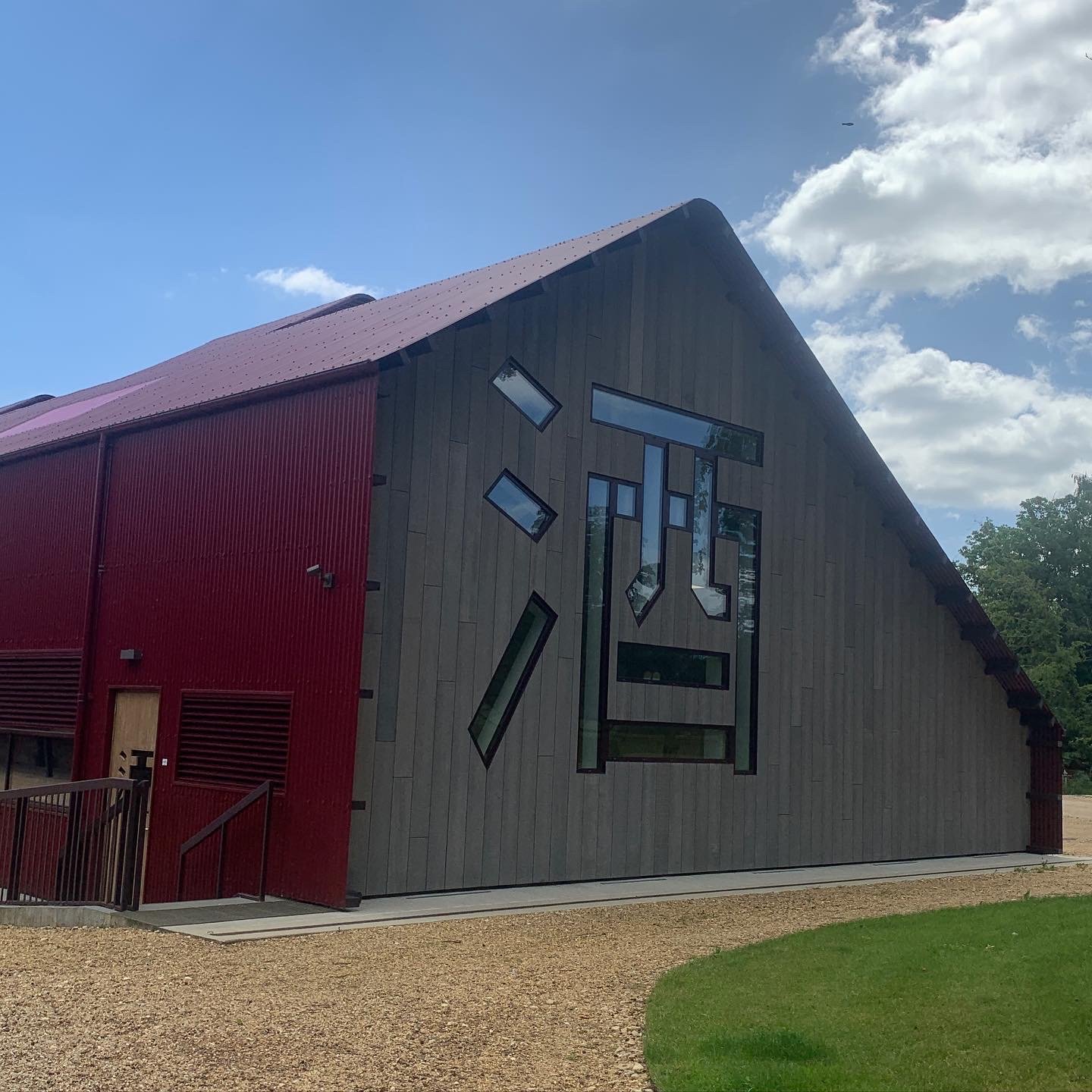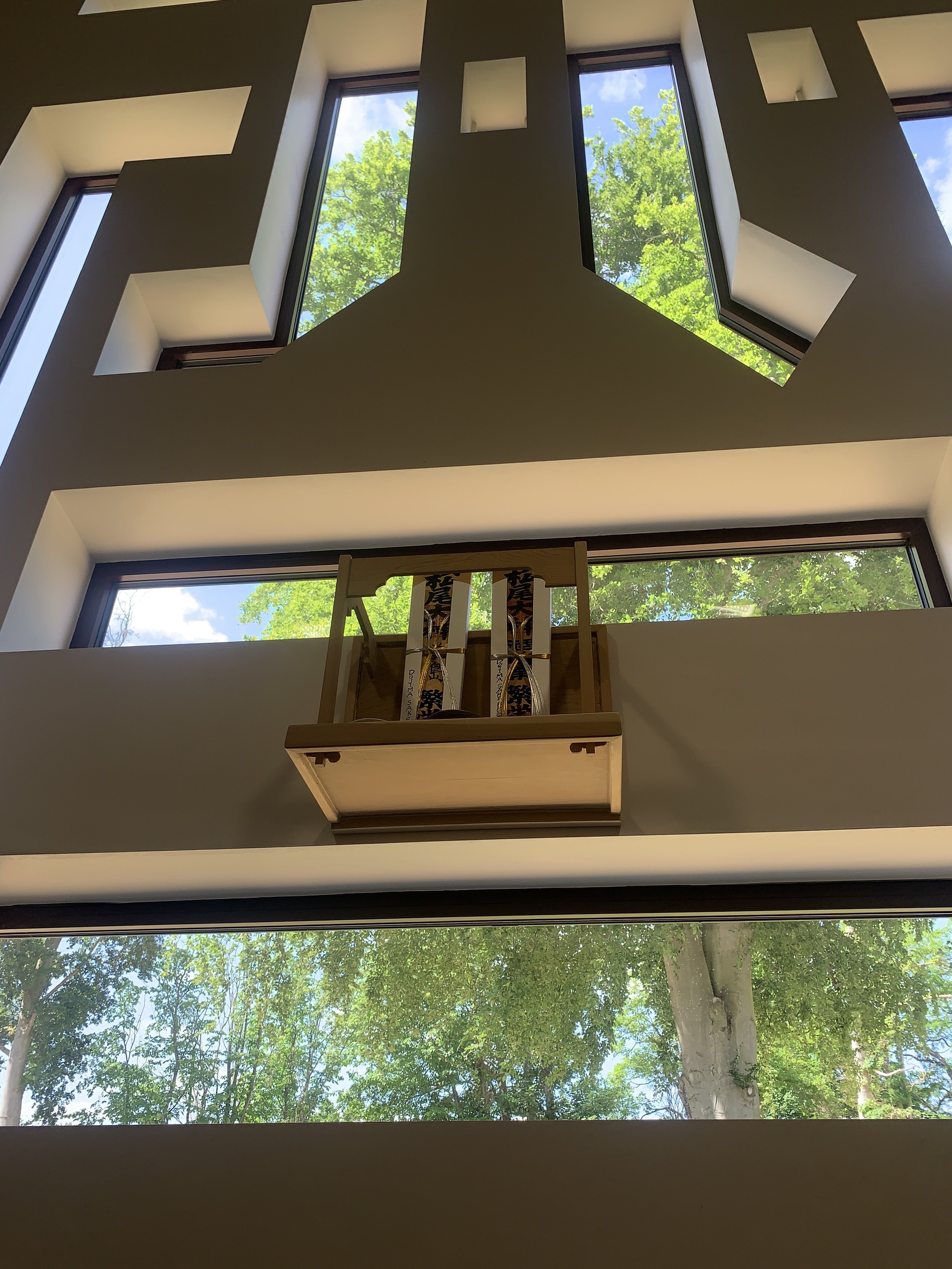Dojima Brewery Visit
I am a huge fan of field trips, especially when you have fun end of terms ones where the day is just about having fun, learning stuff and drinking fine alcohol. This particular trip was hinted at during term but because a very last minute addition, which saw Tate and I, plus most of our cohort, a few lecturers and their plus ones, and a few PhD candidates getting the train to Ely to visit Fordham Abbey and Dojima Brewery in Cambridgeshire.
The Abbey is gorgeous and is owned by the Hashimoto family. It is the first Japanese-owned sake brewery in the UK and has been making small batches of premium junmai sake (Cambridge and Dojima) since 2018. They have also renovated the grounds of the Abbey to reintroduce elements like a kitchen garden, Victorian-style green houses and use much of their produce to feed visitors on their brewery tours.
Ofuda to Ōyamagui-no-Kami (大山咋神) and Ichikishimahime-no-Mikoto (市杵島姫命) on the inside of the 酒 sign of the brewery.
They have also created a Japanese-style garden and are in the progress of building and consecrating a Shinto jinja to the sake kami, Ōyamagui-no-Kami (大山咋神) and Ichikishimahime-no-Mikoto (市杵島姫命), who are enshrined at Matsu Taisha, Kyoto.
The tour began with coffee, lemon cake and delicious cigare tuile biscuits from Yoku Moku (nom!) on the terrace overlooking the garden. We’d struck gold in terms of the weather and it was glorious, with perfect blue skies, interesting conversation about the origins of the brewery in Osaka and a chance to just enjoy ourselves before diving into the mad chaos of essay and dissertation writing.
The day itself was about sake. We began by getting our gear on, which meant hair nets for al and shoe coverings. Tate go to go lay on a comfy couch and be petted (brewerys, even in-active ones out of season, are up there with ICU and hospital theatres and I’m okay with that; I may have been tempted to bargain her for bottles of sake…).
The brewery itself is in a custom building emblazened with 酒, the kanji for sake, and on the inside wall is a kamidana, a small Shinto shrine usually translated as ‘kami shelf’, in which ofuda (sacred paper talismans from a jinja) to Ōyamagui-no-Kami (大山咋神) and Ichikishimahime-no-Mikoto were enshrined. My colleague, shinto priest Hiro-san, got very excited at this and notified the kami-sama of our presence, which was very much appreciated.
Examples of a rice sack (reading 酒米; ‘sake rice’), various degrees of polished rice in Show and Tell containers and empty bottles showing the Cambridge and Dojima branding (note: these bottles are 75cl!).
The tour began with Hashimoto Kumiko-san explaining her family history, their attempts at micro-brewing and their eventual migration to the UK. She then showed us how sake is made, using local water (which is delicious and incredibly good for sake making) and rice and kōji mould (aspergillus oryzae) imported from Japan.
Due to the weather and cultural custom, brewing usually takes place in Winter. Rice and sake can only be harvested after Niiname-sai, 新嘗祭, which is usually in November and marks the day when the Emperor of Japan partakes in a ritual celebrating the rice harvest. After this event, sake brewing officially gets started!
The imported—Yamada Nishiki—rice is steamed (not cooked) and then implanted with the kōji, allowed to mature in a temperature-controlled vault and is then pressed in what can only be called a ginormous metal apple cider-style press called a fune. Then the sake is bottled and, where appropriate, aged on site.
Dojima and two variants of Cambridge (a word pun on 懸橋); freshly pressed and aged for three years.
Finally it was time to try the sake (which retails for an eye-watering £1000 a bottle, though it does come with a host of benefits.) We got to watch a perfectly pitched video on production values, the importance of Shinto in the process and the general ikigai/ethos of the brewery. Kumiko-san presented each of us with the tray below containing a glass of the Dojima sake, and two of Cambridge (one fresh, the other aged three years).
So what does £1000 sake taste like?
Well all of it was delicious; Dojima was nice but my heart lies with Cambridge; the fresh sake is nice but aged is just amazing, like drinking a really nice bottle of white wine. The best part was that these were not stingy shot-sized tasters but lovely highball glasses with a good two fingers of sake in each. Even better we took them downstairs with us for lunch, which was perfectly balanced to match the alcohol, as well as making use of the by-product sake kasu.
The in-progress Shinto jinja to Ōyamagui-no-Kami (大山咋神) and Ichikishimahime-no-Mikoto (市杵島姫命).
After trying the sake, it was time for lunch. The meal was three courses and was delicious: we started with a vegatable and miso soup with some side-dishes, a piece of grilled salmon wth plenty of veggies, rice and asparagus, with cheese cake covered in match powder for desert. The food was so visually stunning and delicious that I forgot to take photos of them. Sorry…
We had just enough time to visit the gardens after lunch, which was a lovely mix of classic English garden and Japanese aesthetics, including a pond, a potting shed, a kitchen garden and an in-progress jinja. This later aspect was the most fascinating as this is not just some ornamental feature but a proper consecrated space, which will be dedicated to the sake kami. It was also being built by British builders and there was a lot more brick than I would have expected as Shinto jinja are usually made of natural materials like wood. I can’t wait to see the final building, though, as well as return and try more sake next year.
All in all it was a really enjoyable day out, from both an educational but also end-of-term-field-trip way. We got to mix a tour with fine food and alcohol, as well as the most perfect weather you could ask for. Thanks must go to Simon Kaner for organising the trip, Ollie Moxham for getting us there and the Hashimoto family for hosting us.






